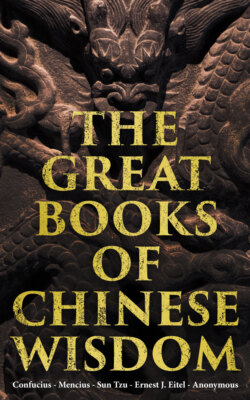Читать книгу The Great Books of Chinese Wisdom - Mencius - Страница 7
Footnotes
Оглавление1. Confucian Analects, VII, xvi.
2. The Historical Records; Life of Confucius, p. 12.
3. Analects, VII, xvii.
4. Legge's Chinese Classics, I, prolegomena, pp. 6-9.
5. Books of the Earlier Han; History of Literature, pp. 1, 2.
6. See the Kâu Kwan (or Lî), Book XXIV, parr. 3, 4, and 27. Biot (Le Tcheou Lî, vol. ii, pp. 70, 71) translates the former two paragraphs thus: 'Il (Le Grand Augure) est préposé aux trois methodes pour les changements (des lignes divinatoires). La première est appelée Liaison des montagnes (Lien-shan); la seconde, Retour et Conservation (Kwei-ȝhang); la troisième, Changements des Kâu. Pour toutes il y a huit lignes symboliques sacrées, et soixante-quatre combinaisons de ces lignes.'
Some tell us that by Lien-shan was intended Fû-hsî, and by Kwei-ȝhang Hwang Tî; others, that the former was the Yî of the Hsiâ dynasty, and the latter that of Shang or Yin. A third set will have it that Lien-shan was a designation of Shăn Năng, between Fû-hsî and Hwang Tî. I should say myself, as many Chinese critics do say, that Lien-shan was an arrangement of the lineal symbols in which the first figure was the present 52nd hexagram, Kăn consisting of the trigram representing mountains doubled; and that Kwei-ȝhang was an arrangement where the first figure was the present 2nd hexagram, Khwăn consisting of the trigram representing the earth doubled,--with reference to the disappearance and safe keeping of plants in the bosom of the earth in winter. All this, however, is only conjecture.
7. See in the Ȝo Khwan, under the 22nd year of duke Kwang (B.C. 672); the 1st year of Min (1661); and in his 2nd year (660); twice in the 15th year of Hsî (645); his 25th year (635); the 12th year of Hsüan, (597); the 16th year of Khăng (575); the 9th year of Hsiang (564); his 25th year (548); the 5th year of Khâo (537); his 7th year (535); his 12th year (530); and the 9th year of Âi (486).
8. That is, the third as it appears farther on in this volume in two Sections. With the Chinese critics it forms the fifth and sixth Appendixes, or, 'Wings,' as they are termed.
9. Sze-mâ Khien (History of the Kâu Dynasty, p. 3) relates that, 'when he was confined in Yû-lî, Wăn increased the 8 trigrams to 64 hexagrams.'
10. E.g., hexagrams XVII, 1. 6; XLVI, 1. 4. Tan's authorship of the symbolism is recognised in the Ȝo Khwan, B. C. 540.
11. P. Regis (vol. ii, P. 379) says: 'Vel nihil vel parum errabit qui dicet opus Yî King fuisse perfectum anno quinto Khăng Wang, seu anno 1109 aut non ultra annum 1108, ante aerae Christianae initium; quod satis in rebus non omnino certis.' But the fifth year of king Khăng was B. C. 1111.
12. It has been suggested that 'Antiquissimus Sinarum liber' may mean only 'A very ancient book of the Chinese,' but the first sentence of the Preface to the work commences:--'Inter onmes constat librorum Sinicorum, quos classicos vocant, primum et antiquissimum esse Y-King.'
At the end of M. De Guignes' edition of P. Gaubil's translation of the Shû, there is a notice of the Yî King sent in 1738 to the Cardinals of the Congregation de Propaganda Fide by M. Claude Visdelou, Bishop of Claudiopolis. M. De Guignes says himself, 'L' Y-King est le premier des Livres Canoniques des Chinois.' But P. Visdelou writes more guardedly and correctly:--'Pour son ancienneté, s'il en faut croire les Annales des Chinois, il a été commencé quarante-six siècles avant celui-ci. Si cela est vrai, comme toute la nation l'avoue unanimement, ou peut à juste titre l'appeler le plus ancien des livres.' But he adds, 'Ce n'étoit pas proprement un livre, ni quelque chose d'approchant; c'étoit une énigme très obscure, et plus difficile cent fois à expliquer que celle du sphinx.'
P. Couplet expresses himself much to the same effect in the prolegomena (p. xviii) to the work called 'Confucius Sinarum Philosophus,' published at Paris in 1687 by himself and three other fathers of the Society of Jesus (Intorcetta, Herdritch, and Rougemont). Both they and P. Visdelou give an example of a portion of the text and its interpretation, having singularly selected the same hexagram,--the 15th, on Humility.
13. See a communication on certain new views about the Yî in the 'Times' of April 20, 1880; reprinted in Trübner's American, European, and Oriental Literary Record, New Series, vol. i, pp. 125-127.
14. Regis' coadjutors in the work were the Fathers Joseph de Mailla, who turned the Chinese into Latin word for word, and compared the result with the Mankâu version of the Yî; and Peter du Tartre, whose principal business was to supply the historical illustrations. Regis himself revised all their work and enlarged it, adding his own dissertations and notes. See Prospectus Operis, immediately after M. Mohl's Preface.
